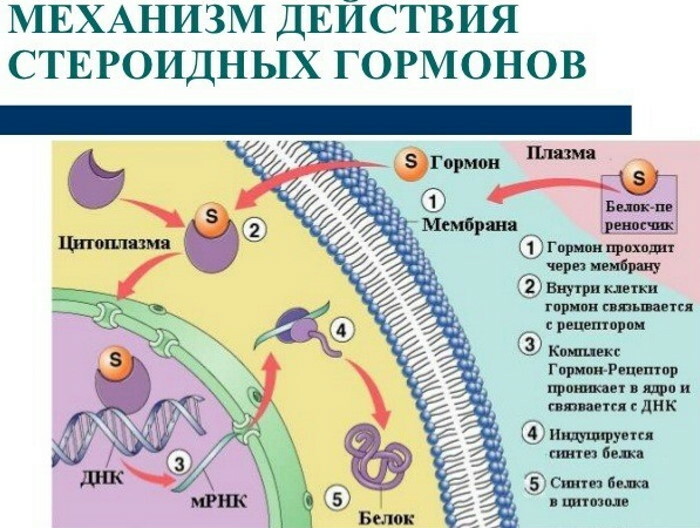Content
- What is cholecystopancreatitis
- Species, their symptoms and signs
- Complications
- Analyzes and diagnostics
- Treatment of cholecystopancreatitis in adults
- Drug therapy
- Physiotherapy
- Diet therapy
- Traditional methods of treatment
- Forecast
- Video about cholecystitis
Relatively rare cholecystopancreatitis disease can cause a wide range of dangerous complications, which are always characterized by strong painful symptoms. With improperly delivered or untimely treatment, the risk of death in an adult patient significantly increases.
What is cholecystopancreatitis
Cholecystopancreatitis (symptoms and treatment in adults are carried out exclusively by an experienced specialist, as well as after a complex diagnostics), is such a pathological process, which is characterized by the presence of an inflammatory reaction in the gallbladder and pancreas.
The disease is characterized by numerous symptomatic manifestations that occur along with persistent painful sensations. The development of such a pathology indicates a violation in the transport and production of various enzymes that perform the function of digestion.
The pathological process has a peculiar course of the disease due to the fact that the patient can often the periods of remission and exacerbation change, which is especially characteristic in the case of incorrect or untimely treatment.
The disease is also characterized by a decrease in function in the breakdown of carbohydrate and fatty structures. In addition, the patient often has a deficiency of gastric juice and fermented elements, which can lead to the formation of other dangerous diseases.
Numerous studies indicate that approximately 70-75% of patients who experience an acute type of cholecystopancreatitis, the parenchyma of the gland changes, which provokes the development of dangerous complications. In addition, patients with a chronic form of the disease are most often affected by cholecystitis and ulcerative colitis.
Species, their symptoms and signs
Cholecystopancreatitis (symptoms and treatment in adults is based on the individual characteristics of the body) is characterized by the presence of a classification in which the types of the pathological process proceed from morphological disorders and the nature of the course diseases.
The main types of cholecystopancreatitis:
| Variety | Description |
| Spicy | Often occurs due to mechanical damage or rough dietary norms. This variety is characterized by rather pronounced painful sensations. It is the most dangerous form of the disease, the mortality rate of which can range from 35 to 60%. |
| Chronic | The disease develops gradually, the main cause of which is often gallstone disease. In this case, the patient has symptomatic manifestations of a dyspeptic nature, while the patient complains of constant discomfort in the hypochondrium and epigastric region. The disease progresses with degenerative changes in the gastrointestinal tract. |
| Relapsing | It often develops as a result of an acute type of pathological process, therefore it always flows into a chronic type. With this type of disease, the risk of death in the presence of exacerbations reaches up to 6-9%. |
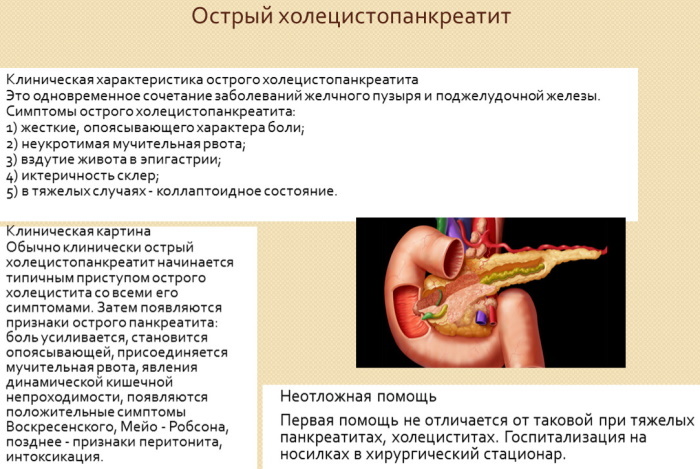
The main symptomatic manifestation in acute or chronic development of the disease is increasing pain in the abdominal region, which can go closer to the ribs or give to the lower back. Also frequent and bilious vomiting is a characteristic feature, which does not bring any relief.
Disorders of the dyspeptic spectrum in the form of belching, heavy feeling in the abdomen and increased nausea are observed in all types of pathological process. Also, patients often note various disorders in the stool, which is characterized by discoloration of feces with an admixture of foods that have not been digested.
Cholecystopancreatitis (symptoms and treatment in adults should be supervised by a qualified professional) characterized by an accelerated darkening of urine, which occurs due to the ingress of pathogenic microorganisms there and bile products.
The spicy variety often appears immediately after a meal, including drinking alcoholic beverages and fatty foods. In this case, the patient complains of radiating pain, belching, significant bloating, and bitterness in the mouth. In the most severe cases, painful manifestations are felt in the region of the lower and upper extremities, passing into the lumbar region.
Complications
Cholecystopancreatitis, with improperly prescribed or untimely treatment, provokes the development of severe complications, the symptoms of which can harm the body of an adult to a greater extent. Lienterea and steatorrhea often develop in patients, and significant weight loss is often observed.
As the pathological process develops, in many cases, digestive insufficiency can form in patients, which is associated with disorders in the urinary system. Also, diabetes mellitus often develops, jejunitis and duodenitis occurs due to infection in the tissues of the small intestine.
The most severe complications of the disease include pancreatic necrosis, which develops as a result of the activation of harmful enzymes inside the pancreatic ducts. Patients also often have lesions such as empyema and pericholecystitis.

The lack of timely and effective treatment leads to perforation of the internal tissues of the organ, which provokes the release of the infectious substance into the abdominal cavity. Research indicates that this significantly increases the risk of biliary peritonitis.
Exacerbation of the pathological process is often accompanied by the formation of multiple organ failure, which can often lead to death or failure of important organs.
Analyzes and diagnostics
Cholecystopancreatitis (symptoms and treatment in adults are aimed at addressing the underlying cause disease) is suspected if the patient has a history of typical complaints and negative physical manifestations.
In order to confirm the diagnosis, in medical practice they use complex studies, which include not only biochemical, but also instrumental types of diagnostics:
- Biochemical and extensive blood count. Distinctive features of the pathological process are an increase in the level of direct bilirubin and alkaline phosphatase type, because the occurrence of tissue necrosis of the pancreas is characterized by a significant increase in ALT and AST.
- Analysis of feces and urine. If there is a suspicion of a disease, such a diagnosis allows you to determine the amount of food that has not been digested, which signals the loss of the functional qualities of the organ. In this case, the analysis indicates the presence of starch elements and muscle fibers. In this case, fecal ELISA is additionally prescribed, aimed at diagnosing alpha-amylase - the level of fermented structures.
- Abdominal ultrasound. Ultrasound examination of organs such as the pancreas and gallbladder reveals the initial symptoms of tissue damage and necrosis. In this case, the doctor pays special attention to the swelling and thickening of the inner walls. Also, with a confirmed diagnosis, various enzymes are present, and a heterogeneous structure of the parenchyma is observed.
-
Magnetic resonance imaging. So, MRI can be used in the absence of good information content when using other diagnostic methods and analyzes. Tomography makes it possible to study in detail the structural features of the pancreas and biliary system. The technique also makes it possible to timely detect benign formations in the organ and diagnose pathological processes in the liver.
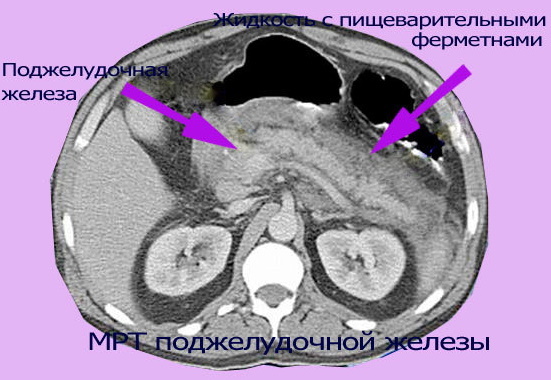
- RHPG. Retrogadal cholangiopancreatography is used to visualize the pathways of the biliary system and pancreatic ducts. This technique allows you to identify malignant calculi and conduct a study of the function of the genitourinary system. In order to exclude pathological manifestations in other organs of the gastrointestinal tract, an extensive X-ray is used.
In addition to the diagnostic methods described above, the doctor can refer the patient to additional tests that are better able to determine the characteristic signs and symptomatic manifestations.
The most important diagnostic study is a complete blood count, which makes it possible to detect an increase in the level of ESR and to quantify the indicator of leukocytosis. If the doctor suspects the presence of helminthiasis, an enzyme-linked immunosorbent blood test is performed.
Treatment of cholecystopancreatitis in adults
Complex treatment of cholecystopancreatitis is prescribed based on the characteristic symptomatic manifestations, the cause of the development of the disease, as well as the degree of damage.
If the patient does not have significant contraindications and complications, complex therapy is carried out, which includes the intake of medicines, physiotherapy procedures, as well as adherence to the correct diet nutrition.
Drug therapy
When determining medications, the doctor must take into account the long-term dynamics of the development of the pathological process, the presence of morphological changes or lesions in the tissues of the organ, as well as the presence in the patient's history of concomitant diseases.
Patients with a pronounced acute course are most often referred to a surgical hospital, where medical workers provide him with proper rest of all organs of the gastrointestinal tract. Antispasmodic and analgesic drugs are also used here.
The main groups of medicinal drugs:
-
Antiemetic drugs. If the patient has regurgitant manifestations, he is most often prescribed drugs that block the production of serotonin and dopamine. Patients with frequent and painful vomiting are shown to use selective blockers.
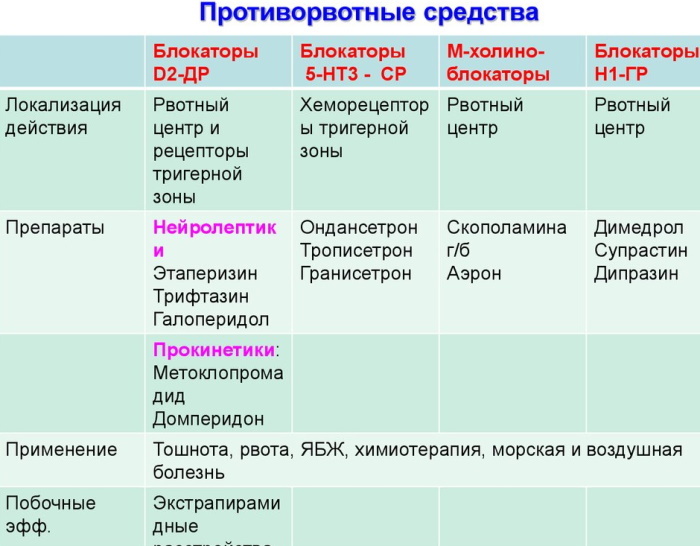
- Antibiotic drugs. In order to prevent dangerous complications of an infectious nature, as well as to eliminate harmful flora, macrolides and aminoglycosides are used. Moreover, their choice should take into account the characteristics of the sensitivity of the viral or bacterial pathogen.
- Narcotic and non-narcotic analgesics. Preparations of the group of analgesics are used in case of frequent painful sensations in the patient, which can largely stop unpleasant manifestations. In the most severe cases, the doctor may prescribe antipsychotic medications.
- Antisecretory group means. In order to eliminate pancreatic secretion, your doctor may prescribe a number of drugs that block the proton pump. In some cases, it is possible to use inhibitors that affect histamine receptors. The severe course of the disease is stopped with the help of protease inhibitors and various octaleptides.
In addition to the above drugs, a procedure such as infusion therapy can be performed, which involves the direct administration of injections with a large number of analeptics, electrolytes, and glycosides. These medicinal substances help support the natural function of the heart.
In order to improve the general condition of the patient, as well as to carry out further prevention, various mineral and vitamin complexes can be administered. In addition, drugs are prescribed that contribute to the rapid restoration of the intestinal flora.
Physiotherapy
The main advantages of physiotherapeutic effects on the body are: effective relief of spasms, strengthening of the immune system, and suppression of inflammatory processes. Physiotherapy also improves blood flow and activates important metabolic processes.
In some cases, the use of physiotherapeutic methods can eliminate painful sensations from simultaneous increase in the regeneration of tissue structures that were damaged by pathological process.
The most effective physiotherapy techniques are:
- Electrophoresis. Allows you to relieve severe pain and eliminate symptomatic manifestations of pancreatic insufficiency. Thanks to this method, the prescribed drugs enter the body much faster and more efficiently, which is characterized by a cumulative effect. In addition, electric current can improve blood circulation and metabolic processes, as well as increase muscle tone and strengthen the immune system.
- Ultrasound. It is characterized by absorbing, anti-inflammatory and antispasmodic effect. The technique allows you to restore the secretory function of the stomach, and also eliminates persistent painful sensations.
- Laser therapy. The procedure has antimicrobial, analgesic and anti-inflammatory effects. In addition, it makes it possible to increase the regenerative properties of tissues, which leads to an improvement in blood flow in tissues and lymph. This method in many cases increases immunity and improves overall metabolism.
- Magnetotherapy. Physiotherapy has an analgesic effect, helps to activate the cellular structure of the immune system, and also relieves the local inflammatory process. In addition, it improves many indicators in the analysis of blood and normalizes the function of excretion of bile masses. Many experts believe that magnetotherapy is the most gentle method of therapy, therefore it is best tolerated by patients.
In addition to the methods described above, the following can be used: paraffin baths, warming up, as well as mud baths. Any physiotherapy techniques should be carried out together with the main therapy, which greatly increases the chance of a positive prognosis in the future.
Diet therapy
Specially developed dietary rules for chronic or acute cholecystopancreatitis are introduced for restoration of the natural function of damaged parts of organs, including the pancreas and gall bubble.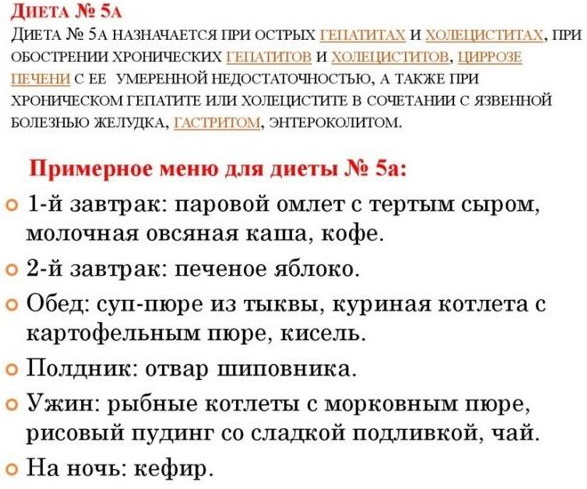
Patients need to refuse to take food that can provoke increased excretion of fermented structures and bile, therefore any smoked, fatty or fried should be avoided dishes. It is also recommended to cut back on alcohol and carbonated drinks.
Effective treatment of cholecystopancreatitis is characterized by the absence of overeating, which can increase the load on those organs and tissues that are affected by the inflammatory process. It is also worth noting that all vegetables and fruits should be as fresh as possible.
The dietary menu is selected on an individual basis, because the patient may have allergic reactions to one or another product. It is especially important that the food is complete, nutritious and high in calories.
When prescribing a food menu, a nutritionist should pay special attention to the presence of secondary pathological processes that occur along with the underlying disease. So, gastritis or ulcerative formations require more stringent dietary recommendations that are aimed at reducing acidity.
The main feature of diet therapy for cholecystopancreatitis is a fairly extensive nutritional norms, which are often used to treat or prevent concomitant diseases.
Such recommendations should be followed daily, and it is especially important to avoid eating dry food. You should also give up alcoholic beverages and smoking, since tobacco smoke can increase the acidity of gastric juice.
Traditional methods of treatment
In order to have an additional effect on the pathological process, therapy can be introduced with the help of folk remedies. This practice should take place in a strictly integrated manner, together with effective drug treatment.
An infusion prepared on the basis of aloe leaves is one of the most effective folk methods. It allows you to relieve the symptomatic manifestations of the disease, as well as to stop the pain syndrome.
To prepare it, you must:
- Cut the leaves of the plant and place them in a small glass container;
- Pour the leaves with a little cold water, then leave to infuse for 5-7 hours;
- The finished tincture is taken orally in 1 tbsp. l. 3 times a day, after being filtered.
In addition to aloe, St. John's wort, ginseng or basil can be used to prepare an effective folk remedy. Also, the patient can make a useful drug from immortelle or peppermint.
Forecast
A positive prognosis indirectly depends on the effectiveness of the therapeutic course, the duration of the pathological process, as well as the degree of degenerative changes in the soft tissues of organs.
If the disease was detected at an early stage, as well as in the presence of timely and effective treatment, the overall prognosis is favorable. The presence of certain complications caused by the pathological process significantly reduces the positive outcome.
Preventive measures include adherence to correct dietary standards, long walks in the fresh air, and complete rejection of bad habits, including the use of alcohol and tobacco.
In order to reduce the risk of recurrent manifestations of cholecystopancreatitis, it is necessary to undergo several cycles of physiotherapeutic procedures, as well as to prescribe effective treatment on time. Such simple recommendations can not only eliminate symptoms, but also increase the overall prognosis of the further course of the disease in adults and children.
Video about cholecystitis
Cholecystitis treatment:

